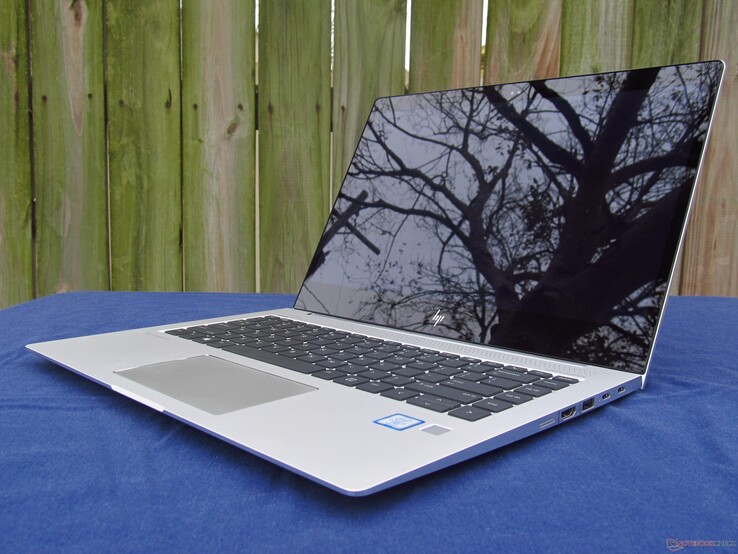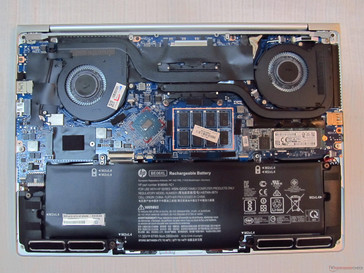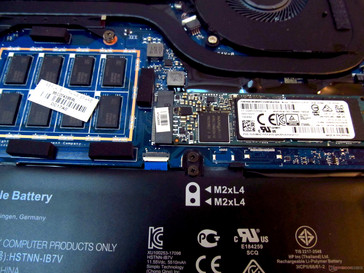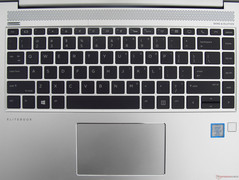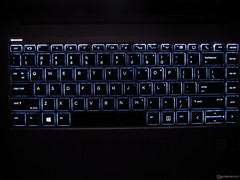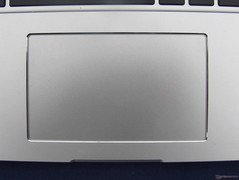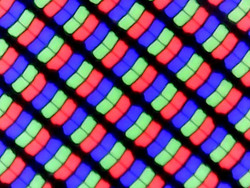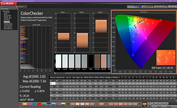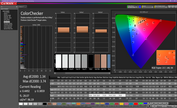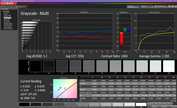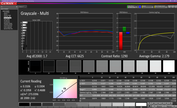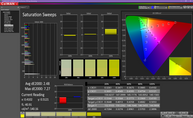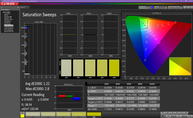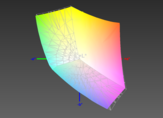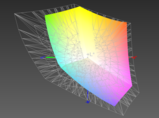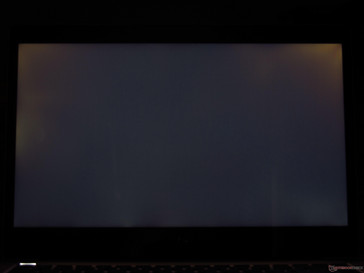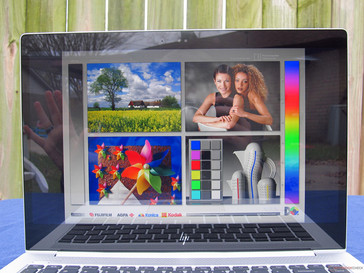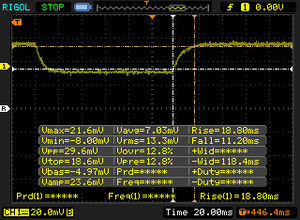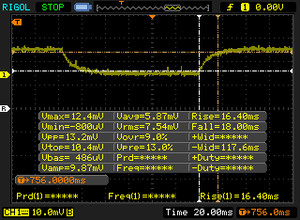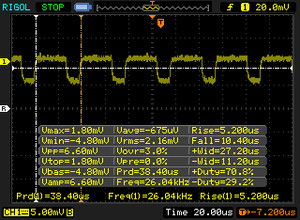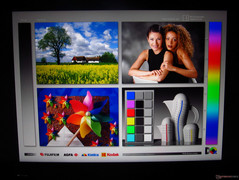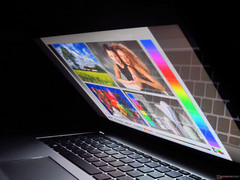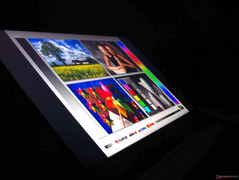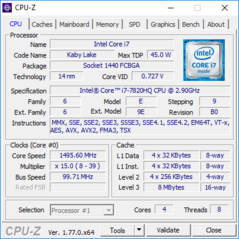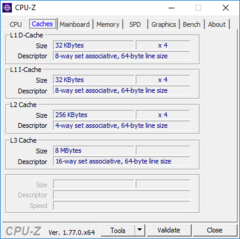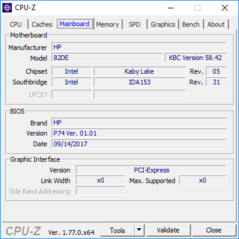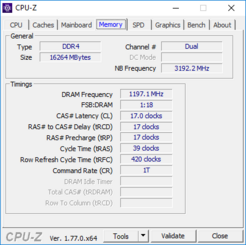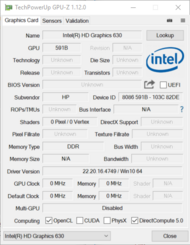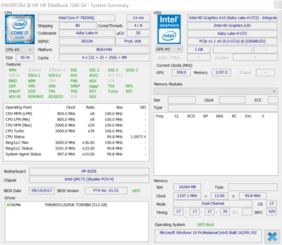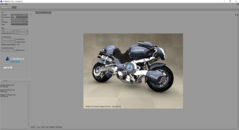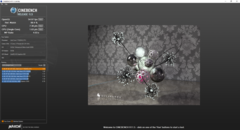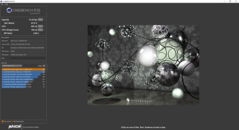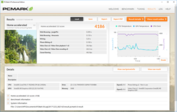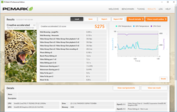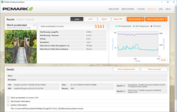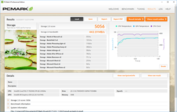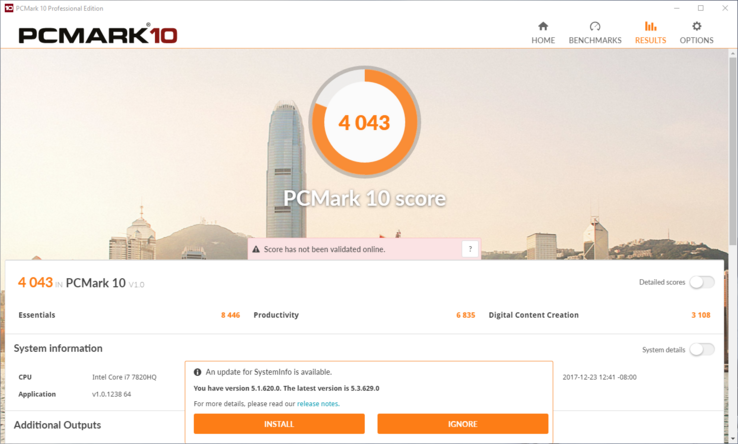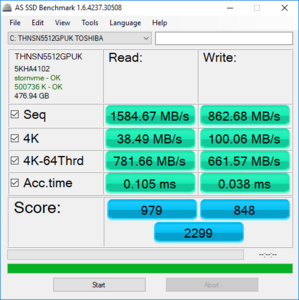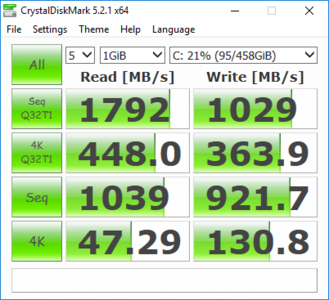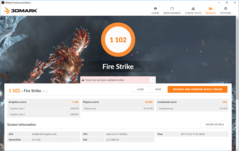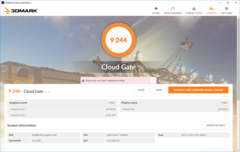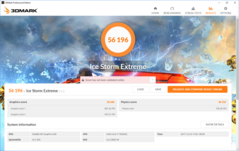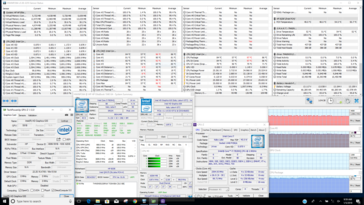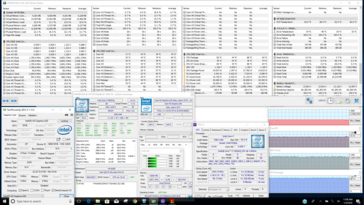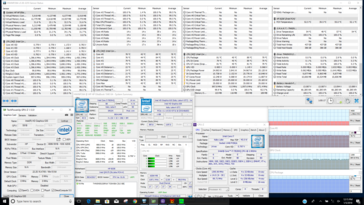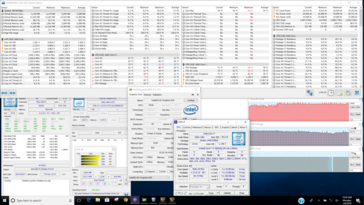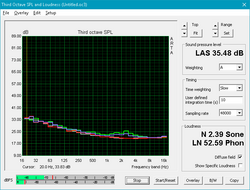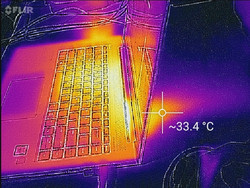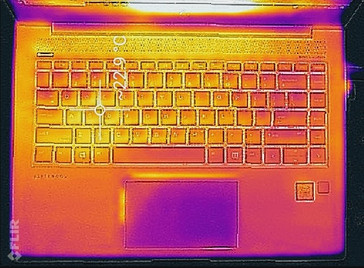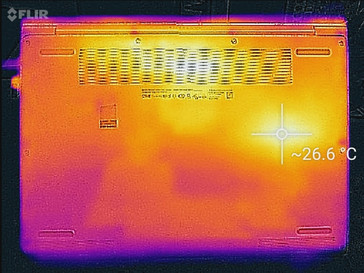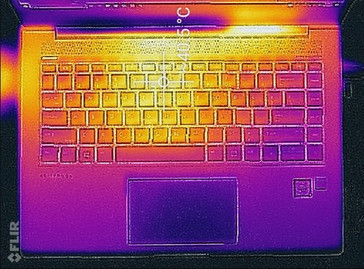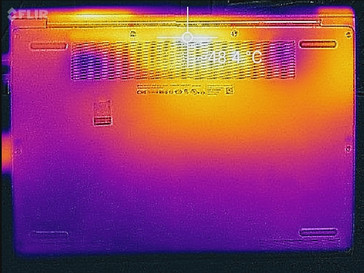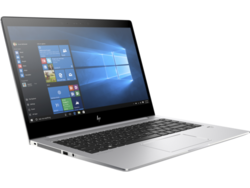HP Elitebook Folio 1040 G4 (FHD, 7820HQ) Laptop Review

HP's EliteBook brand has consistently been one of the top competitors in the premium business notebook market. That trend continues with the latest iteration of the EliteBook Folio 1040 line, the G4. However, HP has a trick up their sleeve this time around; instead of the typical dual-core ULV CPUs found in most ultrabooks and business laptops, the 1040 G4 has an option for a powerful quad-core Intel Core i7-7820HQ.
This processor is more akin to those that power gaming notebooks rather than ultrabooks, and the additional two hyperthreaded cores really push multi-threaded applications. The rest of the system is nothing to sneeze at, either: 16 GB of DDR4 RAM, a 512 GB PCIe NVMe SSD, and a large 67 Wh battery.
As is customary with HP laptops, there are plenty of options. Users that don't need the raw power of the 7820HQ can opt for several different Kaby Lake ULV processors ranging from the Core i5-7200U to the Core i7-7600U. RAM and storage can go up to 32 GB and 1 TB (NVMe), respectively. The RAM is soldered to the motherboard, so buyers will have to decide on how much memory they'll need at checkout. There are also options for either a FHD or 4K screen, both of which come with touch and non-touch enabled panels.
Due to the high-powered processor and the business-centric use case, there is an abundance of competitors. For this review, we will compare the previous generation HP 1040 G3; HP's Spectre x360 15t; Lenovo's ThinkPad T470, T470s, and X1 Carbon (2017); Toshiba's Tecra X40-D; and the Dell XPS 15. Without further ado, let's see how fast this beast can run.
Case
The case screams "high-end business machine" with its aluminum chassis, even gaps, and premium build. There is almost no flex to be had anywhere around the device; the keyboard deck remains firm under all but the most intense force and the bottom panel simply refuses to warp. The chassis also cannot be twisted, and there is no creaking or other unsightly noise when torsion is applied. The weakest point is the display casing, which can be twisted and bent with direct pressure. However, under normal use, the lid remains firm. The hinge is also very well tuned, remaining steady while typing. Touch input will cause some wobbling, but the screen rights itself quickly. Scrolling via touch does not cause the display to move. The hinge also allows for one-finger opening and can open a full 180°.
The matte finish of our silver unit is highly resistant to fingerprints and skin oils; during our review time, we never noticed an unsightly smudge anywhere across the case, keyboard, or trackpad. The glossy finish on the screen will need to be wiped from time to time, however. Overall, the look and feel of the device are among the best on the market. This is a beauty that should hold up well over time.
The HP 1040 G4 is on the smaller side for a 14-inch notebook, comparing favorably to most other business devices on the market. Our review unit is about the same size as the ThinkPad T470s and Toshiba Tecra X40-D. Last year's 1040 G3 is a slight bit longer and wider than the newer G4, but the difference likely won't be noticed by upgraders. Those that need a smaller device should consider the X1 Carbon, which is about 10% smaller than the 1040 G4 (702.3 cm2 vs. 765.7 cm2).
Connectivity
Connectivity is excellent and checks almost every box. The left side has a Kensington lock, ventilation, a USB 3.0 (Gen 1) Type-A port, and a combo headset jack. This USB 3.0 Type-A port also doubles as an always-on charging port for devices like smartphones and tablets, which may come in handy on the road. The right side is where the action is: two Thunderbolt 3 USB Type-C ports (either of which can be used to charge the device), another USB 3.0 (Gen 1) Type-A port, and an HDMI 1.4 port. (Note: We were unable to test whether the Thunderbolt 3 ports offered 2 or 4 PCIe lanes but have reached out to HP for confirmation.) The device also boasts Bluetooth 4.2 and NFC options for wireless connectivity. The only thing missing is an SD card slot of any type; this may be a dealbreaker for some.
Communication & Webcam
Wireless connection speeds are average compared to other business devices. Recieve speeds are good at 630 MBit/s, but transmit speeds are on the low side at 412 MBit/s. Other devices, like the ThinkPad X1 Carbon and HP Spectre x360, offer faster transmit rates over WiFi. During our testing time, we found no complaint with the reliability of WiFi connections; there were no dropped or interrupted connections.
The Elitebook 1040 G4 is designed with teleconferencing in mind. The laptop is certified for Skype for Business and the keyboard has dedicated video call keys, including microphone mute, screen share, answer call, and end call buttons. The speakers (which we will discuss in detail later) are also well-tuned for voice with even mids and highs. It's baffling, then, why HP would equip the device with such a lackluster camera. The resolution is low and details look smeared and crunchy. It's a terrible misstep, especially for a notebook geared towards traveling business people.
Security
The 1040 G4 comes with a slew of security features. For logging in, the machine is equipped with a fingerprint reader and an IR camera. The fingerprint reader is quick but has trouble reading a finger if it's placed off-center. Users will need to make sure that their fingers are placed flat on the reader in order for the reader to work correctly. The IR camera works with Windows Hello for lightning-fast logins. Interestingly, the camera doesn't scan a user's retinas like other devices on the market. Rather, the 1040 G4 seems to rely on facial recognition. While this usually isn't a problem, logins failed anytime we wore glasses and wouldn't work about 50% of the time in very dark environments. On the plus side, the camera could not be fooled by a picture.
The HP 1040 G4 is also equipped with several software-based security measures. There are the usual features like TPM, but HP also includes a Client Security suite, HPSureStart to defend against BIOS-level attacks, and HP Sure Click for enhanced web security when browsing via Internet Explorer or Chromium-based browsers.
Accessories & Warranty
HP includes a USB Type-C to Ethernet adapter with the 1040 G4 and offers a 36-month limited warranty.
Please see our Guarantees, Return Policies and Warranties FAQ for country-specific information.
Maintenance
Maintenance access is fairly straightforward. There are eight Torx T5 screws holding the bottom panel in place. Once these screws are removed, the panel should come free with relative ease as there are only two small clips holding the front of the panel to the main chassis.
Once inside, there's sadly not much to do. The RAM is soldered to the motherboard and irreplaceable. The wireless card is not readily accessible either. The only main components that can easily be swapped out are the storage drive (M.2 SATA or PCIe compatible) and the battery, which will require a bit more disassembly. The fans can be cleaned if needed.
Input Devices
Keyboard
The keyboard is average. The keys are well-sized (~17.5 mm x 17.5 mm) and well-spaced, save the oddly shaped arrow keys. The up and down arrow keys are long and skinny (25.4 mm x 8 mm) and can be difficult to use when navigating documents or spreadsheets. The keys also have a noticeable clatter to them and can be heard over normal office noise. Feedback is well-tuned and the keys have a well-defined drop that feels responsive. Overall, the keyboard isn't bad, but other devices (like the ThinkPad line) have much firmer keyboards with less clatter, more travel, and more responsive feedback.
The keyboard has a two-stage backlight that turns off after about 5 seconds of inactivity. Unfortunately, there is no setting that keeps the white backlight permanently on.
Update 1/18/2018: There is a setting in the system BIOS to set the keyboard backlight timeout. Options range from 5 seconds to 2 minutes. There is also an option to force the keyboard backlight to never turn off.
Touchpad & Touchscreen
The touchpad matches the premium design of the rest of the machine. The surface is a bit larger than average (111.1 mm x 65.1 mm). Thanks to its Windows Precision drivers, tracking and gestures are highly responsive. The entire touchpad registers input. Palm rejection leaves no room for complaint. The glass surface leaves a good impression with a smooth glide. The clicking mechanism is also well made; clicks register without fail and the hinge feels robust. Travel distance is average; the bottom half of the pad noticeably descends upon clicking and offers firm feedback. Clicks sound good and lack the hollow thump found in cheaper touchpads. Windows 10 gestures also register perfectly. Overall, the touchpad is excellent.
The 10-point touchscreen echoes the high quality of the touchpad. Touch input registers accurately and immediately. Scrolling via the touchscreen is smooth. As mentioned, the screen hinge is also firm enough to keep the screen steady when using the touch panel to scroll.
Display
HP offers three different options for the display of the 1040 G4. We have under review the base screen option that has a Full HD IPS panel from Chi Mei rated at 300 nits. Other options include a 400 nit or 700 nit panel, both at either FHD or 4K. Any of these panels can be configured to include a capacitive touchscreen. The 1040 G4 can also be equipped with HP's Sure View technology, which can be activated to reduce the viewing angles of the screen, allowing for better display privacy. Our review unit does not have this hardware feature.
Overall, the display is fairly good. Response times are on the quicker side of average for an IPS panel. PWM is present up to brightness levels of 59%, but the high frequency (~26,000 Hz) will only be noticed by the most sensitive of users. The bottom corners of the screen are dimmer than the upper portion, but this will only be noticed under direct scrutiny. The panel is otherwise evenly backlit.
| |||||||||||||||||||||||||
Brightness Distribution: 87 %
Center on Battery: 295.9 cd/m²
Contrast: 1287:1 (Black: 0.23 cd/m²)
ΔE ColorChecker Calman: 2.83 | ∀{0.5-29.43 Ø4.78}
ΔE Greyscale Calman: 5.2 | ∀{0.09-98 Ø5}
97% sRGB (Argyll 1.6.3 3D)
63% AdobeRGB 1998 (Argyll 1.6.3 3D)
69% AdobeRGB 1998 (Argyll 3D)
97.1% sRGB (Argyll 3D)
66.8% Display P3 (Argyll 3D)
Gamma: 2.28
CCT: 7056 K
| HP Elitebook 1040 G4-2XU40UT Chi Mei CMN14D7, IPS, 14", 1920x1080 | Lenovo ThinkPad X1 Carbon 2017-20HQS03P00 B140HAN03_1, IPS, 14", 1920x1080 | Lenovo ThinkPad T470s-20HGS00V00 B140QAN01.5, IPS, 14", 2560x1440 | HP EliteBook Folio 1040 G3 AUO1136, IPS, 14", 2560x1440 | Toshiba Tecra X40-D Toshiba TOS508F, IPS, 14", 1920x1080 | Dell XPS 15 9560 (i7-7700HQ, UHD) IGZO IPS, 15.6", 3840x2160 | |
|---|---|---|---|---|---|---|
| Display | -10% | 1% | 1% | -38% | 27% | |
| Display P3 Coverage (%) | 66.8 | 61.4 -8% | 69 3% | 67.9 2% | 40.55 -39% | 89.7 34% |
| sRGB Coverage (%) | 97.1 | 85.9 -12% | 95.1 -2% | 96.8 0% | 61 -37% | 100 3% |
| AdobeRGB 1998 Coverage (%) | 69 | 62.4 -10% | 69.6 1% | 70 1% | 41.89 -39% | 100 45% |
| Response Times | -13% | -16% | -12% | 1% | -49% | |
| Response Time Grey 50% / Grey 80% * (ms) | 34.4 ? | 41.6 ? -21% | 46.4 ? -35% | 46.4 ? -35% | 38 ? -10% | 57.2 ? -66% |
| Response Time Black / White * (ms) | 30 ? | 31.6 ? -5% | 28.8 ? 4% | 26.4 ? 12% | 26.8 ? 11% | 39.2 ? -31% |
| PWM Frequency (Hz) | 26040 ? | 20410 ? | 962 | |||
| Screen | -16% | -24% | -10% | -42% | -10% | |
| Brightness middle (cd/m²) | 295.9 | 311 5% | 327 11% | 327 11% | 283.9 -4% | 370.1 25% |
| Brightness (cd/m²) | 287 | 288 0% | 311 8% | 316 10% | 261 -9% | 356 24% |
| Brightness Distribution (%) | 87 | 85 -2% | 88 1% | 87 0% | 85 -2% | 87 0% |
| Black Level * (cd/m²) | 0.23 | 0.24 -4% | 0.25 -9% | 0.35 -52% | 0.25 -9% | 0.37 -61% |
| Contrast (:1) | 1287 | 1296 1% | 1308 2% | 934 -27% | 1136 -12% | 1000 -22% |
| Colorchecker dE 2000 * | 2.83 | 5.5 -94% | 6.1 -116% | 4.39 -55% | 6.4 -126% | 5.3 -87% |
| Colorchecker dE 2000 max. * | 7.34 | 9 -23% | 12.2 -66% | 7.27 1% | 18.7 -155% | 9.9 -35% |
| Greyscale dE 2000 * | 5.2 | 6.2 -19% | 8.8 -69% | 4.69 10% | 6.3 -21% | 4.6 12% |
| Gamma | 2.28 96% | 2.02 109% | 2.18 101% | 2.15 102% | 2.39 92% | 2.31 95% |
| CCT | 7056 92% | 5950 109% | 6172 105% | 7101 92% | 6511 100% | 6284 103% |
| Color Space (Percent of AdobeRGB 1998) (%) | 63 | 55.96 -11% | 61.56 -2% | 62.52 -1% | 38 -40% | 88.3 40% |
| Color Space (Percent of sRGB) (%) | 97 | 85.77 -12% | 94.88 -2% | 96.71 0% | 60 -38% | 100 3% |
| Total Average (Program / Settings) | -13% /
-14% | -13% /
-18% | -7% /
-8% | -26% /
-35% | -11% /
-8% |
* ... smaller is better
Where the 1040 G4's screen really shines is in color reproduction. Out of the box, the screen is very accurate. DeltaE for colors sits at 2.83 sans calibration, which should be accurate enough for professionals. (Generally, a DeltaE less than 3 is considered acceptable for professional color work.) Calibration improves this number to 1.34, making the G4's screen one of the most color accurate displays we've reviewed. Grays are less accurate; the DeltaE for grayscale averages 5.2 but can be improved to 1.7 with calibration.
Speaking of grays, contrast levels are excellent. The contrast ratio is high at about 1287:1, thanks mostly to a low black level of 0.23. Blacks are evenly inky across the panel with no apparent clouding, and dark scenes in movies and media have a smooth gradient without any of the jarring blockiness present in lesser displays. Color temperature is a bit on the warm side at 7056 K. Whites have a very slight blue tint that most won't notice. Again, calibration brings this number closer to perfect, dropping the CCT to about 6625 K.
The weakest point in the screen is the unsightly backlight bleed. The top corners, left side, and bottom edge all exhibit backlight bleed in dark environments. Turning the screen brightness down reduces this, but it is still present even at the lowest setting. It can be distracting during dark scenes.
The glossy finish across the panel is another low point. The screen is usable outdoors as long as the sky is overcast, but reflections can be distracting. HP does offer non-touch display options that have an anti-glare coating.
Display Response Times
| ↔ Response Time Black to White | ||
|---|---|---|
| 30 ms ... rise ↗ and fall ↘ combined | ↗ 11.2 ms rise | |
| ↘ 18.8 ms fall | ||
| The screen shows slow response rates in our tests and will be unsatisfactory for gamers. In comparison, all tested devices range from 0.1 (minimum) to 240 (maximum) ms. » 79 % of all devices are better. This means that the measured response time is worse than the average of all tested devices (20.2 ms). | ||
| ↔ Response Time 50% Grey to 80% Grey | ||
| 34.4 ms ... rise ↗ and fall ↘ combined | ↗ 16.4 ms rise | |
| ↘ 18 ms fall | ||
| The screen shows slow response rates in our tests and will be unsatisfactory for gamers. In comparison, all tested devices range from 0.165 (minimum) to 636 (maximum) ms. » 47 % of all devices are better. This means that the measured response time is similar to the average of all tested devices (31.6 ms). | ||
Screen Flickering / PWM (Pulse-Width Modulation)
| Screen flickering / PWM detected | 26040 Hz | ≤ 59 % brightness setting | |
The display backlight flickers at 26040 Hz (worst case, e.g., utilizing PWM) Flickering detected at a brightness setting of 59 % and below. There should be no flickering or PWM above this brightness setting. The frequency of 26040 Hz is quite high, so most users sensitive to PWM should not notice any flickering. In comparison: 53 % of all tested devices do not use PWM to dim the display. If PWM was detected, an average of 8101 (minimum: 5 - maximum: 343500) Hz was measured. | |||
Because of its IPS panel, the screen has excellent viewing angles. Colors remain stable and text remains legible when viewed at angles of 45 or greater. For those privacy-conscious users concerned with others peeking at their screen, HP also offers displays equipped with their Sure View integrated screen privacy hardware that reduces the viewing angles.
Performance
The exterior of the Elitebook 1040 G4 is beautiful, but is it just another pretty face? In short, no; there is some serious power under the hood. The quad-core Intel Core i7-7820HQ is a far cry faster than the typical U-series CPUs found in most business ultrabooks. Coupled with 16 GB of RAM and a reasonably quick storage drive, the 1040 G4 flies in multi-threaded tasks. Unfortunately, the machine seems to have some trouble keeping its engine cool; there is some thermal throttling present in our testing.
Processor
Intel's Core i7-7820HQ has more in common with gaming notebooks than with office laptops. Featuring a base clock of 2.9 GHz, the processor can boost on a single core up to 3.9 GHz and across all four cores up to 3.5 GHz. Hyperthreading also makes a huge difference in heavier workloads; the chip has twice the processing threads of ULV processors found in other business ultrabooks.
Although it's based on the older Kaby Lake architecture, the CPU still flies through single- and multi-threaded workloads. In Cinebench R15, the 1040 G4 sits near the top of the heap, scoring 166 and 663 in the single and multi tests, respectively. The 7820HQ scores about 80-90% higher than the i7-7500U found in the ThinkPad X1 Carbon and the and i7-7600U used in Toshiba's Tecra X40-D. This shouldn't be too surprising; the 7500U and 7600U are dual-core CPUs rated at 15 W while the 7820HQ is a 45 W quad-core beast.
There are two possible shortcomings that potential buyers should consider. The first is the older platform. Intel's new 8th generation CPUs also offer four cores, even on the lower wattage chips. While not as fast as the 7820HQ, the new U-series of Kaby Lake-R chips should have more than enough punch for most office work while using much less energy. The Core i7-8550U scored about 20% lower than the 7820HQ in Cinebench R15's multi test despite being rated at 1/3 the wattage. The Microsoft Surface Book 2, which uses the faster Core i7-8650U, kept pace with the 7820HQ.
The other failure of the 1040 G4's CPU lies in consistency. In our Cinebench R15 loop test, a definite pattern of a single peak followed by a sharp decrease in performance appeared. The CPU can punch through the benchmark with aplomb once, but can't seem to keep it up and will throttle over extended workloads.
For more about the Intel Core i7-7820HQ, please visit our dedicated CPU page here.
| wPrime 2.10 - 1024m | |
| Toshiba Tecra X40-D | |
| Lenovo ThinkPad T470s-20HGS00V00 | |
| HP Spectre x360 15t-bl100 | |
| HP Elitebook 1040 G4-2XU40UT | |
| Lenovo ThinkPad T470p PL | |
| Dell XPS 15 9560 (i7-7700HQ, UHD) | |
* ... smaller is better
System Performance
Overall system performance is quick and responsive. The 1040 G4 sat atop its competitors in almost every PCMark 8 test, losing to the Microsoft Surface Book 2 in the Creative benchmark (likely due to the latter's dedicated GPU). Apps open immediately and load times are fast. Users will not be left waiting for the system to respond.
| PCMark 8 Home Score Accelerated v2 | 4186 points | |
| PCMark 8 Creative Score Accelerated v2 | 5275 points | |
| PCMark 8 Work Score Accelerated v2 | 5161 points | |
| PCMark 10 Score | 4043 points | |
Help | ||
Storage Devices
The 512 GB Toshiba PCIe NVMe SSD offers adequate, if somewhat disappointing, access times. Read and write speeds sit between 1500-1700 and 800-1000 MB/s, respectively. This is on the low end of what we typically see from NVMe drives. However, considering the business-oriented market of the 1040 G4, most users won't notice any hiccups in loading software or accessing files. Some larger transfers will take a bit longer than competitors equipped with the Samsung PM961, however.
| HP Elitebook 1040 G4-2XU40UT Toshiba XG4 NVMe (THNSN5512GPUK) | Lenovo ThinkPad X1 Carbon 2017-20HQS03P00 Samsung PM961 NVMe MZVLW512HMJP | Lenovo ThinkPad T470p PL Toshiba NVMe THNSF5512GPUK | HP EliteBook Folio 1040 G3 Samsung SM951 MZVPV256HDGL m.2 PCI-e | Toshiba Tecra X40-D Samsung PM961 MZVLW256HEHP | Dell XPS 15 9560 (i7-7700HQ, UHD) Lite-On CX2-8B512-Q11 | Lenovo Yoga 720-13IKB Toshiba XG4 NVMe (THNSN5512GPUK) | HP Spectre x360 15t-bl100 Samsung PM961 NVMe MZVLW512HMJP | |
|---|---|---|---|---|---|---|---|---|
| AS SSD | 84% | -7% | 56% | 39% | 47% | 9% | 99% | |
| Copy Game MB/s (MB/s) | 394.2 | 1145 190% | 617 57% | 540 37% | 413.9 5% | 1134 188% | ||
| Copy Program MB/s (MB/s) | 133.7 | 467.9 250% | 348.7 161% | 411.5 208% | 106.2 -21% | 534 299% | ||
| Copy ISO MB/s (MB/s) | 534 | 1725 223% | 1313 146% | 1272 138% | 755 41% | 1936 263% | ||
| Score Total (Points) | 2299 | 3171 38% | 1855 -19% | 3721 62% | 3576 56% | 2810 22% | 2427 6% | 3781 64% |
| Score Write (Points) | 848 | 1207 42% | 737 -13% | 590 -30% | 675 -20% | 1022 21% | 879 4% | 1556 83% |
| Score Read (Points) | 979 | 1322 35% | 745 -24% | 2095 114% | 1963 101% | 1206 23% | 1049 7% | 1493 53% |
| Access Time Write * (ms) | 0.038 | 0.027 29% | 0.036 5% | 0.03 21% | 0.028 26% | 0.034 11% | 0.034 11% | 0.026 32% |
| Access Time Read * (ms) | 0.105 | 0.028 73% | 0.083 21% | 0.047 55% | 0.061 42% | 0.034 68% | 0.054 49% | 0.04 62% |
| 4K-64 Write (MB/s) | 662 | 905 37% | 542 -18% | 344.3 -48% | 438.4 -34% | 789 19% | 687 4% | 1262 91% |
| 4K-64 Read (MB/s) | 782 | 1022 31% | 568 -27% | 1858 138% | 1663 113% | 962 23% | 828 6% | 1206 54% |
| 4K Write (MB/s) | 100.1 | 151.1 51% | 101.5 1% | 126.6 26% | 124.8 25% | 112.2 12% | 93.8 -6% | 141.1 41% |
| 4K Read (MB/s) | 38.49 | 56.8 48% | 41 7% | 47.72 24% | 51.6 34% | 41.34 7% | 35.88 -7% | 51.9 35% |
| Seq Write (MB/s) | 863 | 1506 75% | 940 9% | 1190 38% | 1117 29% | 1207 40% | 977 13% | 1530 77% |
| Seq Read (MB/s) | 1585 | 2434 54% | 1360 -14% | 1839 16% | 2479 56% | 2026 28% | 1852 17% | 2342 48% |
* ... smaller is better
GPU Performance
Intel's HD Graphics 630 integrated GPU handles all graphical loads for the 1040 G4. The HD Graphics 630 chip is at the higher end of Intel's iGPU offerings, sitting just below their more powerful Iris GPUs. As such, users will see a small bump (about 2-5%) in graphical performance over the more common Intel HD Graphics 620. Expectations should be tempered, though; this is still an integrated GPU and performs far worse than even the lightest dedicated GPUs. The NVIDIA GeForce 940MX used in Lenovo's ThinkPad T470p offers over twice the performance, and the newer MX150 (equivalent to the desktop GT 1030) performs even better, scoring three times as high in 3DMark Fire Strike.
It's a shame that HP didn't include a low-powered GPU like the MX150. A dedicated GPU would have paired nicely with the more powerful i7-7820HQ, and the MX150 is light on power and thermal output. As it stands, the only GPU options currently available are Intel's iGPUs.
For more about the Intel HD Graphics 630, please visit our dedicated GPU page here.
| 3DMark | |
| 1280x720 Cloud Gate Standard Graphics | |
| Dell XPS 15 9560 (i7-7700HQ, UHD) | |
| Microsoft Surface Book 2 | |
| Apple MacBook Pro 15 2017 (2.9 GHz, 560) | |
| HP Spectre x360 15t-bl100 | |
| Lenovo ThinkPad T470p PL | |
| HP Elitebook 1040 G4-2XU40UT | |
| Lenovo ThinkPad T470s-20HGS00V00 | |
| Lenovo Yoga 720-13IKB | |
| Lenovo ThinkPad X1 Carbon 2017-20HQS03P00 | |
| Toshiba Tecra X40-D | |
| Lenovo ThinkPad T470-20HD002HGE | |
| HP EliteBook Folio 1040 G3 | |
| 1920x1080 Fire Strike Graphics | |
| Dell XPS 15 9560 (i7-7700HQ, UHD) | |
| Microsoft Surface Book 2 | |
| Apple MacBook Pro 15 2017 (2.9 GHz, 560) | |
| HP Spectre x360 15t-bl100 | |
| Lenovo ThinkPad T470p PL | |
| HP Elitebook 1040 G4-2XU40UT | |
| Lenovo ThinkPad T470s-20HGS00V00 | |
| Lenovo Yoga 720-13IKB | |
| Lenovo ThinkPad X1 Carbon 2017-20HQS03P00 | |
| Toshiba Tecra X40-D | |
| HP EliteBook Folio 1040 G3 | |
| Lenovo ThinkPad T470-20HD002HGE | |
| 1920x1080 Ice Storm Extreme Graphics | |
| Dell XPS 15 9560 (i7-7700HQ, UHD) | |
| Lenovo ThinkPad T470p PL | |
| HP Spectre x360 15t-bl100 | |
| Microsoft Surface Book 2 | |
| 3DMark 06 Standard Score | 12419 points | |
| 3DMark 11 Performance | 1980 points | |
| 3DMark Cloud Gate Standard Score | 9244 points | |
| 3DMark Fire Strike Score | 1102 points | |
Help | ||
Gaming Performance
Because of the integrated graphics solution, the HP EliteBook 1040 G4 is obviously not a gaming machine. Older titles like Bioshock Infinite can be played, albeit at low resolutions and low graphical settings. However, the latest AAA titles are out of reach, even at the lowest settings. Workers hoping to catch a game in between meetings will want to look at something that sports a dedicated GPU, like Dell's XPS 15 9560.
| BioShock Infinite - 1280x720 Very Low Preset | |
| Microsoft Surface Book 2 | |
| HP Spectre x360 15t-bl100 | |
| Lenovo ThinkPad T470p PL | |
| HP Elitebook 1040 G4-2XU40UT | |
| Lenovo Yoga 720-13IKB | |
| Lenovo ThinkPad X1 Carbon 2017-20HQS03P00 | |
| HP EliteBook Folio 1040 G3 | |
| Lenovo ThinkPad T470s-20HGS00V00 | |
| Lenovo ThinkPad T470-20HD002HGE | |
| Ashes of the Singularity - 1280x768 low | |
| HP Elitebook 1040 G4-2XU40UT | |
| Civilization 6 | |
| 1024x768 Minimum Preset | |
| HP Elitebook 1040 G4-2XU40UT | |
| 1366x768 Medium Preset | |
| HP Elitebook 1040 G4-2XU40UT | |
| low | med. | high | ultra | |
|---|---|---|---|---|
| BioShock Infinite (2013) | 79 | 35 | 30 | |
| Ashes of the Singularity (2016) | 10 | |||
| Civilization 6 (2016) | 42 | 16 |
Stress Test
We have a particular interest in how the high-powered Core i7-7820HQ operates under stress in the thin-and-light chassis. In short, synthetic testing cripples CPU performance, but real-world testing allows the system to flex its muscles. In Prime95, which weighs all CPU threads down with an unrealistic load, we see the 7820HQ stay just under its base clock, settling in at 2.6 GHz. Temperatures are acceptable across the CPU die, averaging about 86° C. The story is similar under FurMark's intense GPU load; the CPU throttles back to 2.0 GHz to allow the Intel HD Graphics 630 to stay near its boost clock of 1100 MHz. Temperatures again remain in the mid-80s.
Running FurMark and Prime95 together noticeably stunts the system. The CPU throttles back to a mere 1.4 GHz while temperatures hit 89° C before falling back down to about 80° C. While this result seems disappointing, keep in mind that these are synthetic tests; it is highly unlikely that any workloads users will actually encounter will be this demanding. Running Unigine Valley for an hour is evidence of this; Valley is more akin to a real-world gaming stress test. During the hour-long benchmark, the CPU is able to hold a boost clock of 3.4 GHz while occasionally shooting up to 3.9 GHz on a single core. The GPU is also able to sit near its rated maximum of 1100 MHz. Temperatures across the silicon hit 92° C (which is a bit toasty) but settle back in at about 78° C.
| CPU Clock (GHz) | GPU Clock (MHz) | Average CPU Temperature (°C) | Average GPU Temperature (°C) | |
| Prime95 Stress | 2.6 | - | 86 | - |
| FurMark Stress | 2.0 | 1057 | 85 | 85 |
| Prime95 + FurMark Stress | 1.4 | 871 | 79 | 79 |
| Unigine Valley | 3.4 | 1054 | 78 | 78 |
Emissions
System Noise
Despite the powerful CPU, the HP Elitebook 1040 G4 is incredibly quiet. During most tasks (web browsing, office work), the fans are not audible over ambient noise. Under load, the fans do ramp up but remain relatively quiet at about 33-35 dB(A). The fans are also low-pitched, which makes them even harder to hear in normal room noise. There is ever-present coil whine present under the center of the device, but it cannot be heard more than a few inches from the chassis. The whine grows louder when the CPU is under strain but remains underneath the quiet fan noise.
Noise level
| Idle |
| 28.2 / 28.2 / 28.2 dB(A) |
| Load |
| 33.3 / 35.3 dB(A) |
 | ||
30 dB silent 40 dB(A) audible 50 dB(A) loud |
||
min: | ||
| HP Elitebook 1040 G4-2XU40UT HD Graphics 630, i7-7820HQ, Toshiba XG4 NVMe (THNSN5512GPUK) | Lenovo ThinkPad X1 Carbon 2017-20HQS03P00 HD Graphics 620, i7-7500U, Samsung PM961 NVMe MZVLW512HMJP | Lenovo ThinkPad T470p PL GeForce 940MX, i7-7700HQ, Toshiba NVMe THNSF5512GPUK | Lenovo ThinkPad T470s-20HGS00V00 HD Graphics 620, i7-7600U, Samsung SSD PM961 1TB M.2 PCIe 3.0 x4 NVMe (MZVLW1T0) | Lenovo ThinkPad T470-20HD002HGE HD Graphics 620, i5-7200U, Samsung PM961 NVMe MZVLW512HMJP | HP EliteBook Folio 1040 G3 HD Graphics 520, 6300U, Samsung SM951 MZVPV256HDGL m.2 PCI-e | Toshiba Tecra X40-D HD Graphics 620, i7-7600U, Samsung PM961 MZVLW256HEHP | Dell XPS 15 9560 (i7-7700HQ, UHD) GeForce GTX 1050 Mobile, i7-7700HQ, Lite-On CX2-8B512-Q11 | Lenovo Yoga 720-13IKB UHD Graphics 620, i5-8550U, Toshiba XG4 NVMe (THNSN5512GPUK) | HP Spectre x360 15t-bl100 GeForce MX150, i5-8550U, Samsung PM961 NVMe MZVLW512HMJP | Microsoft Surface Book 2 GeForce GTX 1050 Mobile, i7-8650U, Samsung PM961 MZVLW256HEHP | Apple MacBook Pro 15 2017 (2.9 GHz, 560) Radeon Pro 560, i7-7820HQ | |
|---|---|---|---|---|---|---|---|---|---|---|---|---|
| Noise | -7% | -10% | -7% | 1% | -3% | -2% | -16% | -5% | -8% | -8% | -9% | |
| off / environment * (dB) | 28.2 | 29.3 -4% | 28.9 -2% | 28 1% | 29.1 -3% | 28 1% | 28.4 -1% | 30.5 -8% | 28.4 -1% | 29.4 -4% | 30.8 -9% | |
| Idle Minimum * (dB) | 28.2 | 29.3 -4% | 30 -6% | 28.9 -2% | 28 1% | 29.1 -3% | 28 1% | 29 -3% | 30.5 -8% | 28.4 -1% | 29.4 -4% | 31 -10% |
| Idle Average * (dB) | 28.2 | 29.3 -4% | 31.4 -11% | 28.9 -2% | 28 1% | 29.1 -3% | 28 1% | 29 -3% | 30.5 -8% | 28.4 -1% | 29.4 -4% | 31 -10% |
| Idle Maximum * (dB) | 28.2 | 32.2 -14% | 32.7 -16% | 30.1 -7% | 29.4 -4% | 29.1 -3% | 28.2 -0% | 32.2 -14% | 30.5 -8% | 28.4 -1% | 29.4 -4% | 31 -10% |
| Load Average * (dB) | 33.3 | 34.3 -3% | 34.4 -3% | 39.2 -18% | 31.4 6% | 32.6 2% | 33.2 -0% | 47.1 -41% | 32.8 2% | 41.6 -25% | 31.4 6% | 31.3 6% |
| Load Maximum * (dB) | 35.3 | 39.3 -11% | 39.5 -12% | 39.2 -11% | 34.6 2% | 37.8 -7% | 39.9 -13% | 47.1 -33% | 34.7 2% | 41.6 -18% | 49 -39% | 41.8 -18% |
| Witcher 3 ultra * (dB) | 52 | 36.1 | 49 |
* ... smaller is better
Temperature
Surface temperatures are very well managed. While the system is idle, the chassis remains cool to the touch. Even under full synthetic load, temperatures across most of the body of the notebook don't exceed 40° C. The keyboard and touchpad remain comfortable. There is a hot spot on the bottom panel directly over the CPU die, so users will want to avoid holding the notebook in their lap during intense workloads.
(±) The maximum temperature on the upper side is 41.6 °C / 107 F, compared to the average of 34.3 °C / 94 F, ranging from 21.2 to 62.5 °C for the class Office.
(-) The bottom heats up to a maximum of 48.4 °C / 119 F, compared to the average of 36.8 °C / 98 F
(+) In idle usage, the average temperature for the upper side is 22.8 °C / 73 F, compared to the device average of 29.5 °C / 85 F.
(+) The palmrests and touchpad are cooler than skin temperature with a maximum of 27.8 °C / 82 F and are therefore cool to the touch.
(±) The average temperature of the palmrest area of similar devices was 27.6 °C / 81.7 F (-0.2 °C / -0.3 F).
Speakers
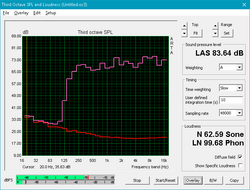
The Bang & Olufsen branded speakers are above average. The Elitebook 1040 G4 has 6 speakers, 4 of which sit across the front of the bottom panel. The subsequent sound profile is fairly full-bodied. Bass is a bit weak but is much more present than on other laptops. Mids and highs are well-balanced and should make for crystal clear conference calls. Considering the 1040 G4 is designed for teleconferencing, the speaker profile is tuned perfectly for this purpose.
HP Elitebook 1040 G4-2XU40UT audio analysis
(±) | speaker loudness is average but good (75.4 dB)
Bass 100 - 315 Hz
(±) | reduced bass - on average 12.4% lower than median
(±) | linearity of bass is average (13.8% delta to prev. frequency)
Mids 400 - 2000 Hz
(+) | balanced mids - only 2.2% away from median
(+) | mids are linear (6.2% delta to prev. frequency)
Highs 2 - 16 kHz
(+) | balanced highs - only 3.3% away from median
(+) | highs are linear (4.6% delta to prev. frequency)
Overall 100 - 16.000 Hz
(+) | overall sound is linear (11.6% difference to median)
Compared to same class
» 3% of all tested devices in this class were better, 2% similar, 95% worse
» The best had a delta of 7%, average was 21%, worst was 53%
Compared to all devices tested
» 7% of all tested devices were better, 2% similar, 90% worse
» The best had a delta of 4%, average was 24%, worst was 134%
Lenovo ThinkPad X1 Carbon 2017-20HQS03P00 audio analysis
(±) | speaker loudness is average but good (78.2 dB)
Bass 100 - 315 Hz
(-) | nearly no bass - on average 16.5% lower than median
(±) | linearity of bass is average (8.7% delta to prev. frequency)
Mids 400 - 2000 Hz
(+) | balanced mids - only 2.9% away from median
(+) | mids are linear (5% delta to prev. frequency)
Highs 2 - 16 kHz
(+) | balanced highs - only 3.8% away from median
(+) | highs are linear (6% delta to prev. frequency)
Overall 100 - 16.000 Hz
(±) | linearity of overall sound is average (16.3% difference to median)
Compared to same class
» 18% of all tested devices in this class were better, 6% similar, 76% worse
» The best had a delta of 7%, average was 21%, worst was 53%
Compared to all devices tested
» 26% of all tested devices were better, 6% similar, 69% worse
» The best had a delta of 4%, average was 24%, worst was 134%
Toshiba Tecra X40-D audio analysis
(±) | speaker loudness is average but good (77.3 dB)
Bass 100 - 315 Hz
(-) | nearly no bass - on average 15.2% lower than median
(±) | linearity of bass is average (7.2% delta to prev. frequency)
Mids 400 - 2000 Hz
(+) | balanced mids - only 3.6% away from median
(+) | mids are linear (5.7% delta to prev. frequency)
Highs 2 - 16 kHz
(±) | higher highs - on average 5.6% higher than median
(+) | highs are linear (5.2% delta to prev. frequency)
Overall 100 - 16.000 Hz
(±) | linearity of overall sound is average (22% difference to median)
Compared to same class
» 56% of all tested devices in this class were better, 8% similar, 35% worse
» The best had a delta of 7%, average was 21%, worst was 53%
Compared to all devices tested
» 63% of all tested devices were better, 6% similar, 31% worse
» The best had a delta of 4%, average was 24%, worst was 134%
Frequency Comparison (Checkbox selectable!)
Graph 1: Pink Noise 100% Vol.; Graph 2: Audio off
Energy Management
Power Consumption
Surprisingly, the Elitebook 1040 G4 does not consume much power in spite of its 45 W CPU. On average, the 1040 G4 pulls about 10% more from the wall than other business-centric devices that opt for Intel's 15 W U-series chips when under load. Compared to more powerful devices (like those equipped with the Core i7-7700HQ), the 1040 G4 draws significantly less power, but this may be due to the dedicated GPUs in competing machines.
At about 130 x 65 x 29 mm and 433 g, the 90 Watt power adapter is heavier and larger than those included with other ultraportables but provides more than enough power for the 1040 G4.
| Off / Standby | |
| Idle | |
| Load |
|
Key:
min: | |
| HP Elitebook 1040 G4-2XU40UT i7-7820HQ, HD Graphics 630, Toshiba XG4 NVMe (THNSN5512GPUK), IPS, 1920x1080, 14" | Lenovo ThinkPad X1 Carbon 2017-20HQS03P00 i7-7500U, HD Graphics 620, Samsung PM961 NVMe MZVLW512HMJP, IPS, 1920x1080, 14" | Lenovo ThinkPad T470p PL i7-7700HQ, GeForce 940MX, Toshiba NVMe THNSF5512GPUK, , 2560x1440, 14" | Lenovo ThinkPad T470s-20HGS00V00 i7-7600U, HD Graphics 620, Samsung SSD PM961 1TB M.2 PCIe 3.0 x4 NVMe (MZVLW1T0), IPS, 2560x1440, 14" | Lenovo ThinkPad T470-20HD002HGE i5-7200U, HD Graphics 620, Samsung PM961 NVMe MZVLW512HMJP, IPS, 1920x1080, 14" | HP EliteBook Folio 1040 G3 6300U, HD Graphics 520, Samsung SM951 MZVPV256HDGL m.2 PCI-e, IPS, 2560x1440, 14" | Toshiba Tecra X40-D i7-7600U, HD Graphics 620, Samsung PM961 MZVLW256HEHP, IPS, 1920x1080, 14" | Dell XPS 15 9560 (i7-7700HQ, UHD) i7-7700HQ, GeForce GTX 1050 Mobile, Lite-On CX2-8B512-Q11, IGZO IPS, 3840x2160, 15.6" | Lenovo Yoga 720-13IKB i5-8550U, UHD Graphics 620, Toshiba XG4 NVMe (THNSN5512GPUK), IPS, 1920x1080, 13.3" | HP Spectre x360 15t-bl100 i5-8550U, GeForce MX150, Samsung PM961 NVMe MZVLW512HMJP, IPS, 3840x2160, 15.6" | Microsoft Surface Book 2 i7-8650U, GeForce GTX 1050 Mobile, Samsung PM961 MZVLW256HEHP, IPS, 3000x2000, 13.5" | Apple MacBook Pro 15 2017 (2.9 GHz, 560) i7-7820HQ, Radeon Pro 560, , , 2880x1800, 15.4" | |
|---|---|---|---|---|---|---|---|---|---|---|---|---|
| Power Consumption | 15% | -31% | 4% | 32% | -2% | 25% | -114% | 14% | -69% | -44% | -51% | |
| Idle Minimum * (Watt) | 5.1 | 3.84 25% | 3.9 24% | 4.64 9% | 3.21 37% | 6.3 -24% | 5.2 -2% | 11.9 -133% | 3.8 25% | 11.6 -127% | 4.7 8% | 3.7 27% |
| Idle Average * (Watt) | 7 | 6.3 10% | 9.4 -34% | 8.93 -28% | 6.15 12% | 9.4 -34% | 6.9 1% | 17.1 -144% | 8.4 -20% | 13.8 -97% | 10.6 -51% | 16.2 -131% |
| Idle Maximum * (Watt) | 11.7 | 8.6 26% | 12.2 -4% | 9.12 22% | 6.82 42% | 10.1 14% | 7 40% | 17.3 -48% | 9.7 17% | 14.2 -21% | 12.3 -5% | 18 -54% |
| Load Average * (Watt) | 41.2 | 41.9 -2% | 73.3 -78% | 42.2 -2% | 28.5 31% | 33.3 19% | 24.6 40% | 94.7 -130% | 36 13% | 67.9 -65% | 81 -97% | 58.4 -42% |
| Load Maximum * (Watt) | 56.9 | 48.7 14% | 93.4 -64% | 47.3 17% | 34.5 39% | 49.5 13% | 30.1 47% | 122 -114% | 36 37% | 76.9 -35% | 100.3 -76% | 89.6 -57% |
| Witcher 3 ultra * (Watt) | 104.8 | 59 | 97 |
* ... smaller is better
Battery Life
The 67 Wh battery is a marathon runner. During our WiFi Surfing v1.3 benchmark (Balanced profile, screen set to 150 nits, loading a new webpage every 30-40 seconds), the HP Elitebook 1040 G4 lasted a staggering 11 hours 5 minutes. This blows most competitors out of the water and should leave even the busiest road warriors satisfied. During Battery Eater's Reader test (Power Saver profile, minimum brightness, Airplane mode), the 1040 G4 lasted nearly an entire day, shutting down after 22 and a half hours. The 1040 G4 is quick-charge capable via the included power adapter, which can charge the battery from 5% to full in about 1 hour 10 minutes.
| HP Elitebook 1040 G4-2XU40UT i7-7820HQ, HD Graphics 630, 67 Wh | Lenovo ThinkPad X1 Carbon 2017-20HQS03P00 i7-7500U, HD Graphics 620, 57 Wh | Lenovo ThinkPad T470p PL i7-7700HQ, GeForce 940MX, 48 Wh | Lenovo ThinkPad T470s-20HGS00V00 i7-7600U, HD Graphics 620, 51 Wh | Lenovo ThinkPad T470-20HD002HGE i5-7200U, HD Graphics 620, 48 Wh | HP EliteBook Folio 1040 G3 6300U, HD Graphics 520, 45.6 Wh | Toshiba Tecra X40-D i7-7600U, HD Graphics 620, 48 Wh | Dell XPS 15 9560 (i7-7700HQ, UHD) i7-7700HQ, GeForce GTX 1050 Mobile, 97 Wh | Lenovo Yoga 720-13IKB i5-8550U, UHD Graphics 620, 48 Wh | HP Spectre x360 15t-bl100 i5-8550U, GeForce MX150, 79.2 Wh | Microsoft Surface Book 2 i7-8650U, GeForce GTX 1050 Mobile, 75 Wh | Apple MacBook Pro 15 2017 (2.9 GHz, 560) i7-7820HQ, Radeon Pro 560, Wh | |
|---|---|---|---|---|---|---|---|---|---|---|---|---|
| Battery runtime | -6% | -45% | -26% | -11% | -25% | -17% | -22% | -30% | -3% | 36% | -15% | |
| Reader / Idle (h) | 22.5 | 20.9 -7% | 12.3 -45% | 13.1 -42% | 8.8 -61% | 14.6 -35% | 13.9 -38% | 15.6 -31% | 24.5 9% | |||
| WiFi v1.3 (h) | 11.1 | 8.3 -25% | 7 -37% | 7.3 -34% | 5.2 -53% | 6 -46% | 7.2 -35% | 7.8 -30% | 8.5 -23% | 11.1 0% | 11.3 2% | |
| Load (h) | 1.6 | 1.8 13% | 1.6 0% | 1.8 13% | 2.2 38% | 2.1 31% | 1.7 6% | 2.3 44% | 3.2 100% | 1.1 -31% | ||
| WiFi (h) | 5.1 | |||||||||||
| Witcher 3 ultra (h) | 3.8 | 1.3 |
Pros
Cons
Verdict
The HP EliteBook 1040 G4 wraps powerful components in a beautiful chassis. The option for a quad-core 45 W CPU may be a boon for professionals in need of more power than is offered by the 15 W dual-core chips typically used in business notebooks. The speakers are fantastic and perfectly tuned for teleconferencing and the battery can literally last all day and charges very quickly. HP set out to make the perfect "road warrior" notebook and succeeded... mostly.
It's perplexing that a laptop geared toward Skype calls and video conferences has such a lackluster webcam, for one. Also, the display backlight is uneven at the highest settings; the lower corners are dimmer than the upper corners, which might be distracting to discerning users. The keyboard is also just average and falls short of the more satisfying offerings on the market. Finally, the absence of a dedicated GPU, even a low-powered one, is a missed opportunity. The Core i7-7820HQ feels somewhat wasted without more graphics horsepower to back it up.
The other fly in the ointment is Kaby Lake-R. The new 8th generation chips bring four cores to the 15 W CPU line, offering similar power in a much more energy efficient design. The architecture is still too new for a definitive comparison, but Kaby Lake-R will likely be able to hit a similar level of performance with much less heat output and even less strain on battery life.
So how does the Elitebook Folio 1040 G4 compare to other 14-inch business notebooks like the X1 Carbon and Latitude lines? There's no doubt that HP makes the current powerhouse in this market. The quad-core i7-7820HQ is miles ahead of competitors. However, this lead will likely be cut once Dell and Lenovo release updated versions of their machines with quad-core 8th generation Intel silicon inside. The 1040 G4 will likely still be more powerful, but this power will come at a cost of comparatively lower battery life.
In addition, competitors from Lenovo and Dell offer much better maintenance options and best-in-class keyboards. These are two areas the 1040 G4 compromises on. Potential buyers will need to consider how much processing power they really need and determine if the extra punch is worth some shortcomings in other areas. That said, the 1040 G4 by no means a bad machine in these respects; it just falls short of its competition.
If you are a frequent traveler who spends a significant amount of time in teleconferences and are in need of serious computational power, the HP Elitebook 1040 G4 is a good choice. You just might want to invest in a dedicated webcam.
HP Elitebook 1040 G4-2XU40UT
- 12/26/2017 v6 (old)
Sam Medley




